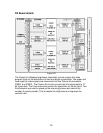
32
Main Power Supply
Figure 30
Power Factor Control
The power factor control circuit operates like a boost regulator. The incoming AC
voltage, after being switched on, enters the rectifier D402 where it is converted to
DC. The Power Factor Control (PFC) circuit converts the DC level to 400Vdc.
The negative side of the bridge rectifier D402 connects to ground via a resistor.
As current flows through the resistor, the resulting voltage drop enters pin 5 of
connector P19/P19A of the power factor control circuit board. The power factor
control circuit board is a switching control oscillator circuit which boosts the input
voltage at pin 2 of the transformer T401 to 400Vdc. As the pulses are output at
pin 4 of connector P19/P19A, the transistors Q400~Q405 are switched On/Off
controlling the charge and discharge time of the inductor L401. The output
voltage is monitored via pin 11 of the connector P19/P19A. The resistor R548
adjusts the output voltage to 400Vdc. The 400Vdc output to pin 2 of the
transformer T401 subsequently enters the drain of transistor Q416.


















